Multiple choice question for engineering
Set 1
1. Shape of the resonance curve depends upon the?
a) Q-factor
b) Voltage
c) Current
d) Either voltage or current
Answer
Answer: a [Reason:] The shape of the resonance curve depends on the Q factor because of the equation:
BW=fr/Q.
2. A circuit is said to be selective if it has a _____ peak and ____ bandwidth.
a) Blunt, narrow
b) Sharp, narrow
c) Sharp, broad
d) Blunt, broad
Answer
Answer: b [Reason:] A circuit is said to be selective in nature if it has a shape peak with a narrow bandwidth.
3. What is the Q factor of a selective circuit?
a) Vey low
b) Very high
c) Zero
d) Infinity
Answer
Answer: b [Reason:] A circuit is said to be selective in nature if it has a shape peak with a narrow bandwidth. The sharp peak indicates a high Q factor.
4. In selective circuits, higher the Q factor _________ the peak.
a) Sharper
b) Blunter
c) Neither sharper nor blunter
d) Either sharper or blunter
Answer
Answer: a [Reason:] A circuit is said to be selective in nature if it has a shape peak with a narrow bandwidth. The sharp peak indicates a high Q factor.
5. Q is a measure of _________
a) Resonance
b) Bandwidth
c) Selectivity
d) Either resonance or bandwidth
Answer
Answer: c [Reason:] A circuit is said to be selective in nature if it has a shape peak with a narrow bandwidth. The sharp peak indicates a high Q factor.
6. In selective circuits, the resonant frequency lies in the ________ of the bandwidth frequency range.
a) Beginning
b) End
c) Midpoint
d) Cannot be determined
Answer
Answer: c [Reason:] In selective circuits, the resonant frequency lies in the mid point of the bandwidth frequency range.
7. In order for high selectivity, the resistance must be?
a) Small
b) Large
c) Negative
d) Positive
Answer
Answer: a [Reason:] For high selectivity, the Q factor should be large and for Q factor to be large, the resistance would be small because Q is inversely proportional to the resistance.
8. What is the frequency in resonance condition?
a) Minimum
b) Maximum
c) Cannot be determined
d) Zero
Answer
Answer: b [Reason:] At resonance condition, the frequency is maximum since the inductive reactance is equal to the capacitive reactance and the voltage and current are in phase.
9. If the resonant frequency in a series RLC circuit is 50kHz along with a bandwidth of 1kHz, find the quality factor.
a) 5
b) 50
c) 100
d) 500
Answer
Answer: b [Reason:] We know that Quality factor is equal to the resonant frequency divided by the bandwidth. Substituting the values from the given question, we get Q=50.
10. What happens to the quality factor when the bandwidth increases?
a) Increases
b) Decreases
c) Remains the same
d) Becomes zero
Answer
Answer: b [Reason:] We know that Quality factor is equal to the resonant frequency divided by the bandwidth. Hence as the bandwidth increases, quality factor decreases.
Set 2
1. Find the current in the circuit.
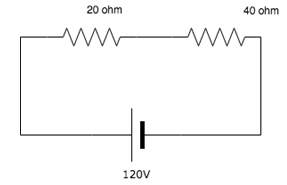
a) 10 A
b) 20 A
c) 30 A
d) 40 A
Answer
Answer: b [Reason:] I=V/R. Total resistance = 20+40=60ohm. I=120V. I=120/60=20A.
2. In a series circuit, which of the parameters remain constant across all circuit elements such as resistor, capacitor and inductor etcetera?
a) Voltage
b) Current
c) Both voltage and current
d) Neither voltage nor current
Answer
Answer: b [Reason:] In a series circuit, the current across all elements remain the same and the total volt-age of the circuit is the sum of the voltages across all the elements.
3. Voltage across the 60ohm resistor is______
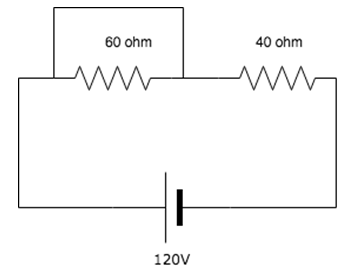
a) 72V
b) 0V
c) 48V
d) 120V
Answer
Answer: b [Reason:] The 60ohm resistance is shorted since current always choses the low resistance path. Voltage across short circuit is equal to zero, hence voltage across the resistor is 0.
4. Find the voltage across the 6 ohm resistor.
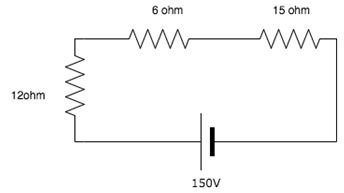
a) 150V
b) 181,6V
c) 27.24V
d) 54.48V
Answer
Answer: c [Reason:] Total current=150/(6+12+15)=4.55A. V across 6ohm=Total current x re-sistance=4.55×6=27.24V.
5. If there are two bulbs connected in series and one blows out, what happens to the other bulb?
a) The other bulb continues to glow with the same brightness
b) The other bulb stops glowing
c) The other bulb glows with increased brightness
d) The other bulb also burns out
Answer
Answer: b [Reason:] Since the two bulbs are connected in series, if the first bulb burns out there is a break in the circuit and hence the second bulb does not glow.
6. What is the value of x if the current in the circuit is 5A?

a) 75 ohm
b) 65 ohm
c) 55 ohm
d) 45 ohm
Answer
Answer: a [Reason:] Total voltage=sum of voltages across each resistor. =>150=10*5+5*5+5*x. Solving the equation, we get x=75 ohm.
7. Voltage across a series resistor circuit is proportional to?
a) The amount of time the circuit was on for
b) The value of the resistance itself
c) The value of the other resistances in the circuit
d) The power in the circuit
Answer
Answer: b [Reason:] V=IR hence voltage across a series resistor circuit is proportional to the value of the resistance.
8. Many resistors connected in series will?
a) Divide the voltage proportionally among all the resistors
b) Divide the current proportionally
c) Increase the source voltage in proportion to the values of the resistors
d) Reduce the power to zero
Answer
Answer: a [Reason:] In a series circuit, the current remains the same across all resistors hence the voltage divides proportionally among all resistors.
9. What is the voltage measured across a series short?
a) Infinite
b) Zero
c) The value of the source voltage
d) Null
Answer
Answer: b [Reason:] A short is just a wire. The potential difference between two points of a wire is zero hence the voltage measured is equal to zero.
10. What happens to the current in the series circuit if the resistance is doubled?
a) It becomes half its original value
b) It becomes double its original value
c) It becomes zero
d) It becomes infinity
Answer
Answer: a [Reason:] I=V/R. Hence if R=2R V=I/2R, and I=I/2.
Set 3
1. It is preferable to connect bulbs in series or in parallel?
a) Series
b) Parallel
c) Both series and parallel
d) Neither series nor parallel
Answer
Answer: b [Reason:] Bulbs are connected in parallel so that even if one of the bulbs blow out, the others continue to get a current supply.
2. Calculate the total resistance between the points A and B.
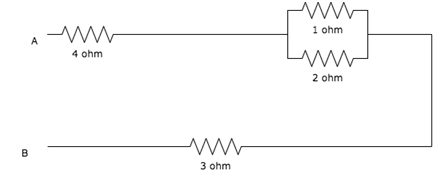
a) 7 ohm
b) 0 ohm
c) 7.67 ohm
d) 0.48 ohm
Answer
Answer: c [Reason:] Total resistance= 1||2 in series with 3 ohm and 4 ohm.
3. Calculate the equivalent resistance between A and B.
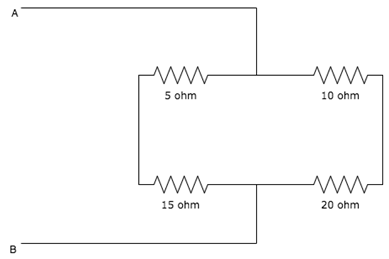
a) 60 ohm
b) 15 ohm
c) 12 ohm
d) 48 ohm
Answer
Answer: c [Reason:] The 5 ohm and 15 ohm resistances are connected in parallel with the series connec-tion of the 10 ohm and 30 ohm resistors.
4. Calculate the resistance between A and B.
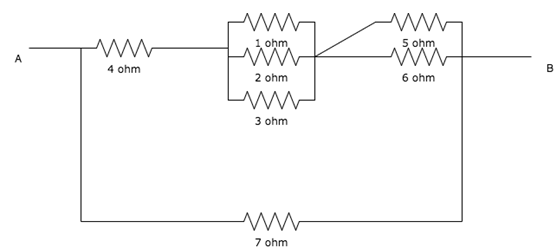
a) 3.56 ohm
b) 7 ohm
c) 14.26 ohm
d) 29.69 ohm
Answer
Answer: a [Reason:] The 1 ohm, 2 ohm and 3 ohm resistors are connected in series. Its equivalent re-sistance is in series with the 4 ohm resistor and the parallel connection of the 5 ohm and 6 ohm resistor. The equivalent resistance of this combination is 7.26 ohm. The 7.26 ohm and the 7 ohm resistor are connected in parallel hence the total resistance=3.56 ohm.
5. Batteries are generally connected in______
a) Series
b) Parallel
c) Either series or parallel
d) Neither series nor parallel
Answer
Answer: a [Reason:] Batteries are generally connected in series so that we can obtain the desired voltage since voltages add up once they are connected in series.
6. In a _________ circuit, the total resistance is greater than the largest resistance in the circuit.
a) Series
b) Parallel
c) Either series or parallel
d) Neither series nor parallel
Answer
Answer: a [Reason:] In series circuits the total resistance is the sum of all the resistance in the circuit, hence the total is greater than the largest resistance.
7. In a ____________ circuit, the total resistance is smaller than th smallest resistance in the circuit.
a) Series
b) Parallel
c) Either series or parallel
d) Neither series nor parallel
Answer
Answer: b [Reason:] in a parallel circuit, the equivalent resistance=1/sum of the reciprocals of all the re-sistances in the circuit. Hence it is smaller than the smallest resistance in the circuit.
8. Which is the most cost efficient connection?
a) Series
b) Parallel
c) Either series or parallel
d) Neither series nor parallel
Answer
Answer: a [Reason:] The advantage of series-connections is that they share the supply voltage, hence cheap low voltage appliances may be used.
9. Calculate the equivalent resistance between A and B.
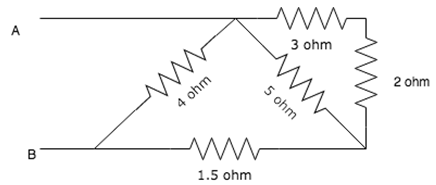
a) 2 ohm
b) 4 ohm
c) 6 ohm
d) 8 ohm
Answer
Answer: a [Reason:] R=((2+3)||5)+1.5)||4.The 2 and the 3 ohm resistor are in series. The equiva-lent of these two resistors is in parallel with the 5 ohm resistor. The equivalent of these three resistances is in series with the 4 ohm resistor. Finally, the equivalent of these re-sistances is in parallel with the 1.5 ohm resistor.
10. Calculate the equivalent resistance between A and B.
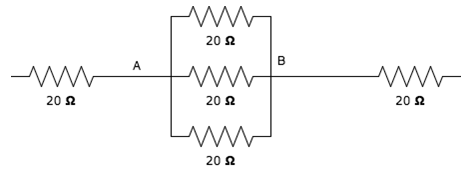
a) 6.67 ohm
b) 46.67 ohm
c) 26.67 ohm
d) 10.67 ohm
Answer
Answer: a [Reason:] R=20||20||20=6.67 ohm. The three 20 ohm resistors are in parallel and re-sistance is measured across this terminal.
Set 4
1. From the given circuit, find the value of IR.
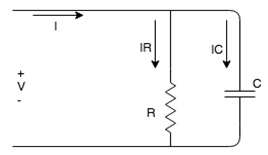
a) 0
b) V/I
c) V/R
d) Cannot be determined
Answer
Answer: c [Reason:] In the given circuit, the voltage across the resistor is the same as the source voltage as they are connected in parallel. The current in the resistor is IR hence IR=V/R.
2. What is the relation between IR and V in the following circuit?

a) IR leads V
b) IR lags V
c) IR and V are in phase
d) No relation
Answer
Answer: c [Reason:] In the following circuit IR and V are in phase because IR is the current in the resistor and the current in the resistor is always in phase with the voltage across it.
3. What is the expression for the current in the inductor from the following circuit?

a) V/I
b) V/XL
c) 0
d) Cannot be determined
Answer
Answer: b [Reason:] In the given circuit, the voltage across the inductor is the same as the source voltage as they are connected in parallel. The current in the inductor is IL hence IL=V/XL.
4. What is the phase relation between IL and V from the following circuit?

a) IL lags V
b) IL leads V
c) IL and V are in phase
d) No relation
Answer
Answer: a [Reason:] IL is the current across the inductor and we know that the current across the inductor always lags the voltage across it. Hence IL lags V.
5. Find the expression for the current I from the given circuit.

a) I=IL
b) I=IR
c) I=IL+IR
d) I=0
Answer
Answer: c [Reason:] I is the total current in the circuit. Since this is a parallel connection, the total current in the circuit is equal to the sum of the currents in each branch of the circuit. Hence I=IR+IL.
6. Find the total current if IL=2A and Ir=5A.

a) 3A
b) -3A
c) 7A
d) 10A
Answer
Answer: c [Reason:] We know that I=IR+IL.
Substituting the values from the question, we get I=7A.
7. Find the value of IR if I=10A and IL=8A.

a) 5A
b) 18A
c) 12A
d) 2A
Answer
Answer: d [Reason:] We know that I=IR+IL.
Substituting the values from the question, we get IR=2A.
8. Find the value of IL if I=10A and IR=6A.

a) 4A
b) 18A
c) 12A
d) 2A
Answer
Answer: a [Reason:] We know that I=IR+IL.
Substituting the values from the question, we get IL=4A.
9. What is the expression for the current in the capacitor in the following circuit?

a) V/C
b) V/I
c) 0
d) V/XC
Answer
Answer: d [Reason:] In the given circuit, the voltage across the capacitor is the same as the source voltage as they are connected in parallel. The current in the capacitor is IC hence IC=V/XC.
10. What is the phase relation between IC and V from the following circuit?

a) IC lags V
b) IC leads V
c) IC and V are in phase
d) No relation
Answer
Answer: b [Reason:] IC is the current across the capacitor and we know that the current across the capacitor always leads the voltage across it. Hence IC leads V.
Set 5
1. A voltage source connected in series with a resistor can be converted to a?
a) Current source in series with a resistor
b) Current source in parallel with a resistor
c) Voltage source in parallel with a resistor
d) Cannot be modified
Answer
Answer: b [Reason:] A voltage source connected in series can be converted to a current source connected in parallel using the relation obtained from ohm’s law, that is V=IR. This equation shows that a voltage source connected in series has the same impact as a current source connected in parallel.
2. Calculate the total current in the circuit.
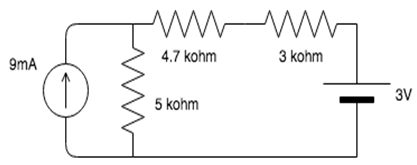
a) 2.3mA
b) 4.3mA
c) 3.3mA
d) 1.3mA
Answer
Answer: c [Reason:] The 9mA source connected in parallel to the 5 kohm resistor can be converted to a 45V source in series with a 5 kohm resistor. Applying mesh analysis, we get:
I=(45-3)/(5+4.7+3)= 3.3mA.
3. Find the value of voltage once source transformation is applied to the circuit.
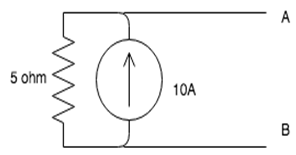
a) 10V
b) 30V
c) 50V
d) 70V
Answer
Answer: c [Reason:] Using ohm’s law, we can use the relation: V=IR.
Thus V=10*5= 50V.
4. Once the circuit is transformed to a voltage source where will the resistance be connected?

a) In series with the voltage source
b) In parallel with the voltage source
c) The resistance is removed from the circuit
d) Resistance is multiplies by 10 and connected in series with the source
Answer
Answer: a [Reason:] The resistance is connected in series with the voltage source because we are transforming a current source connected in parallel to a resistor to a voltage source connected in series with it.
5. What will the value of the current be once source transformation is applied to the circuit?
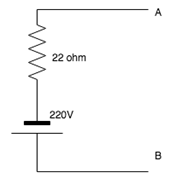
a) 10A
b) 20A
c) 30A
d) 40A
Answer
Answer: a [Reason:] Using ohm’s law, we can use the relation: V=IR.
Thus I=V/R.
I=220/22=10A.
6. Once the circuit is transformed to a current source where will the resistance be connected?

a) In series with the voltage source
b) In parallel with the voltage source
c) The resistance is removed from the circuit
d) Resistance is multiplies by 10 and connected in series with the source
Answer
Answer: a [Reason:] When we perform source transformation on a circuit, we transform a voltage source connected in series with a resistor to a current source connected in parallel to it. This is due to the relation we get by ohm’s law, that is: V=IR.
7. A current source connected in parallel with a resistor can be converted to a?
a) Current source in series with a resistor
b) Voltage source in series with a resistor
c) Voltage source in parallel with a resistor
d) Cannot be modified
Answer
Answer: b [Reason:] A current source connected in parallel can be converted to a voltage source connected in series using the relation obtained from ohm’s law, that is V=IR. This equation shows that a current source connected in parallel has the same impact as a voltage source connected in series.
8. A source transformation is_________
a) Unilateral
b) Bilateral
c) Unique
d) Cannot be determined
Answer
Answer: b [Reason:] A source transformation is bilateral because a voltage source can be converted to a current source and vice-versa.
9. In source transformation________
a) Voltage source remain the same
b) Current sources remain the same
c) Both voltage and current source remain the same
d) Resistances remain the same
Answer
Answer: d [Reason:] In source transformation, the value of the voltage and current sources change when changed from voltage to current source and current to voltage source but the value of the resistances remains the same.
10. If there are 3 10V sources connected in parallel then on source transformation__________
a) The effect of all the sources is considered
b) The effect of only one source is considered
c) The effect of none of the sources is considered
d) The effect of only 2 sources is considered.
Answer
Answer: b [Reason:] When voltages are connected in parallel, the effect of only one source is considered because the effect of the voltage remains the same when connected in parallel.
